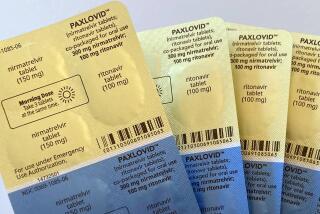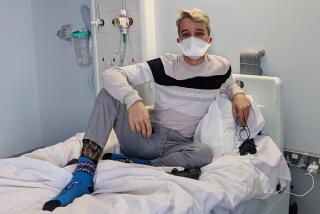Seniors ‘Gung-Ho’ for Research
- Share via
Most old folks fear the flu. At 81, Martha Goldberg challenged it.
When doctors sought residents at the Jewish Home for the Aging willing to become experimental subjects for a new flu drug, Goldberg was the first to sign up when the study began at the Reseda home in January.
“I’m gung-ho about this research,” she said. “I like to see progress and if we don’t try something then we’d never get ahead.”
Doctors soon found that Goldberg wasn’t the only one willing to be a guinea pig. Sixty-nine other septa-, octa- and nonagenarians also signed up, ready to perhaps gamble their health on the power of an experimental drug.
Doctors say the population’s age extremes, the newborn and the elderly, are the most prone to serious harm, even death, from influenza because of weaker immune systems. That’s why researchers are testing Zanamivir on nursing home residents across the United States and Europe. The Jewish Home for the Aging is the only California nursing home taking part.
If it works as researchers hope, Zanamivir should both limit the symptoms of many common flu strains the test subjects may have, and also prevent them from spreading the virus to other people.
The thymus gland, the master gland for the immune system, deteriorates as people enter their 80s and 90s, making the elderly prone to infections, said Dr. Stefan Gravenstein, chief of the Glennan Center for Geriatrics and Gerontology at Eastern Virginia Medical School, and lead investigator of the drug trial.
“This is an ideal population to . . . study,” Gravenstein said.
The study is backed financially by the giant Glaxo Wellcome drug company, which developed Zanamivir.
Zanamivir is a powder. When inhaled, it settles on the mucous lining of the lungs. When the influenza virus attempts to insert its genetic material into the cells of a host, the drug, a neuraminidase inhibitor, blocks the neuraminidase protein the flu virus needs to grow and replicate, Gravenstein said.
The drug is different from others on the market because it is the first to attack the neuraminidase, Gravenstein said. Others, such as Rimantadine, fight another protein called hemagglutinin that the flu virus uses to attach itself to cells.
Unlike a vaccine, which is injected into muscle, Zanamivir acts directly on the lining of the lungs and can remain on the lung’s surface for several days, Gravenstein said.
Though results are preliminary, it appears flu viruses can’t build up as much resistance to Zanamivir as they do to other drugs on the market or to vaccines, he said.
In order to take part in the Jewish Home’s study, patients must first be exposed to the flu. But because this year’s outbreak is on the decline, doctors are now waiting for another round to appear to administer the drug to healthy subjects to see if it protects them.
The flu season peaked some weeks ago. “We had a bad middle of December and first week of January,” said Dr. Shirley Fannin, director of disease control for Los Angeles County. But since then new cases of flu have slacked off, she said. “We’ll probably run into sporadic cases until March, but it’s quieted down a great deal since December.”
Indeed, some of the home’s residents said they may be too hardy to give the drug a workout.
Jule Leeds, 83, said the flu bugs wouldn’t dare touch her. “I’m too ornery, they know enough to stay away from me,” she said.
The earlier outbreak did hit the home however, sickening about 50 of the 700 residents.
Goldberg was one of the unlucky ones. She said she caught the flu in late December right after her regular, nonexperimental flu shot.
She is still waiting to take the experimental drug, which won’t happen until others around her come down with the disease and expose her to infection. So far, only three of the 70 patients participating in the Jewish Home’s study have taken the medication, said Julia Maglione, spokeswoman for the home.
Zanamivir may be tested through one more flu season--October through March--before the data is analyzed, Gravenstein said.
If scientists can prove the drug works, they will request approval from the Food and Drug Administration, a process that can take several years, said Julie Dean, spokeswoman for Glaxo Wellcome.
“It takes . . . an average of around 13 years to take a drug all the way to market,” Dean said. “ We’re hoping this one will be a little quicker.”






